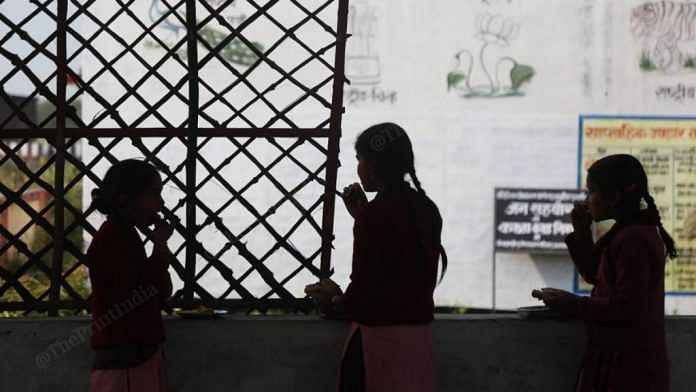New Delhi: A study that seeks to compare elementary education in India and China, which jointly account for about a third of the world’s population, suggests that the former is about 20 years behind its neighbour in terms of taking policy steps towards quality schooling.
The study — a working paper published last month by the Finland-based think tank, United Nations University’s World Institute for Development Economics and Research (UNU-WIDER) — was conducted by two scholars, Naveen Kumar of the University of California San Diego and Vinitha Varghese of the University of Illinois, Chicago.
It seeks to explore “key lessons” India can learn from China, which shifted its focus from ‘quantity’ to ‘quality’ two decades before India’s new National Education Policy (NEP) 2020 came into effect.
The authors say China’s adoption of the “New Curriculum Reform 20 years before India’s NEP 2020 has put China on the path to achieving equitable development of ‘quality’ compulsory schooling”.
However, it adds that “NEP 2020 has components that have the potential to improve quality, equity, and efficiency of the education system”.
India’s ‘late realisation’
In the 1950s, the study says, India and China were almost on the same level in terms of approach to education — focusing on higher education, especially science and technology.
However, according to the study, in the 1960s, China prioritised overcoming illiteracy while India continued to lay emphasis on higher education in science and technology. India brought free and compulsory education in the form of Right to Education (RTE) in 2009, decades after China did, the study notes.
As a result, between 1961 and 1981, China’s literacy rate rose to 68 per cent from 43 per cent, while India’s reached 41 per cent from 28 per cent in the same period.
India’s focus on higher education came at the cost of “addressing mass illiteracy”, says the study, adding that this issue was further exacerbated by “unequal access to education”.
The gaps between the two countries’ literacy rates have since narrowed. According to the World Bank, by 2018, India had a literacy rate of 74 per cent while China’s was 97 per cent.
The UNU-WIDER study notes that most of India’s improvement in literacy has happened in recent years, while China has had an edge for the last thirty years.
“China has been close to the 100 per cent mark since the early 1990s and India improved from a 62 per cent literacy rate (of the 15-24 years age group) in 1990 to 92 per cent in 2018. The difference in gains made in youth literacy rates boils down to India being late to the game of primary education policies,” it says.
Also Read: Gender equality, pride in India: What govt aims to achieve with new school curriculum under NEP
Approaches to elementary education
The next key difference between these countries, the study says, is their approach to primary education.
In the 1970s, the working paper states, China made education compulsory for all, and consequently, its school enrolment rates shot up. By 1985, China’s gross enrolment rate — ratio of number of children in school to number of children in an age group appropriate to the schooling level — reached 100 per cent.
China’s push for primary enrolment showed progress in the 1990s, when its secondary school enrolment rose. In India, the rise in secondary school enrolment, came only after the early 2000s, the study says.
Since the 1990s, an average 25-year-old Chinese individual has always had almost two more years of schooling compared to an Indian, notes the study.
China’s investments in quality
In 2001, China started revamping its education policy to focus on quality education as opposed to exam-oriented rote learning, with the latter system facing a backlash from students’ parents as enrolment rose, the authors note.
Under its new education policy, the Chinese government invested in infrastructure, changed its curriculum, reduced focus on exam-oriented learning and provided incentives for teaching in rural areas.
Although India invested in compulsory and free education, midday meals, building separate toilets for girls and boys, increasing the number of schools etc, the approach, according to the authors, has mostly been to address quantity measures.
“India’s race to increase school access and infrastructure at the cost of efforts to improve teaching quality has led to a widening gap between India and China on quality, equity, and efficiency measures,” says the study.
This led to “increasing isolation of children from less privileged social classes” and school-going children exhibiting “poor learning outcomes” in both public and private schools, it adds.
The way ahead
The authors believe India’s NEP has the potential to bring about reform. From early childhood care and education (ECCE), reforms in teachers’ recruitment and training to standardised tests (measuring learning outcomes using a common benchmark at classes 3, 5 and 8), the NEP can provide the quality push India’s education system needs, the authors say.
But the authors have made some policy suggestions — adding more workers at every pre-school centre, and changing the way teachers are recruited, trained and rewarded. They also recommend that there should be steps to ensure that the standardised test scores are free from data manipulation.
(Edited by Gitanjali Das)
Also Read: 1 Italian, 1 French institute want to set up campus in India under NEP, Modi govt announces



